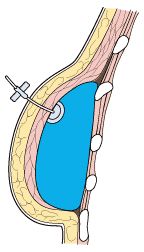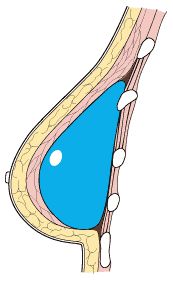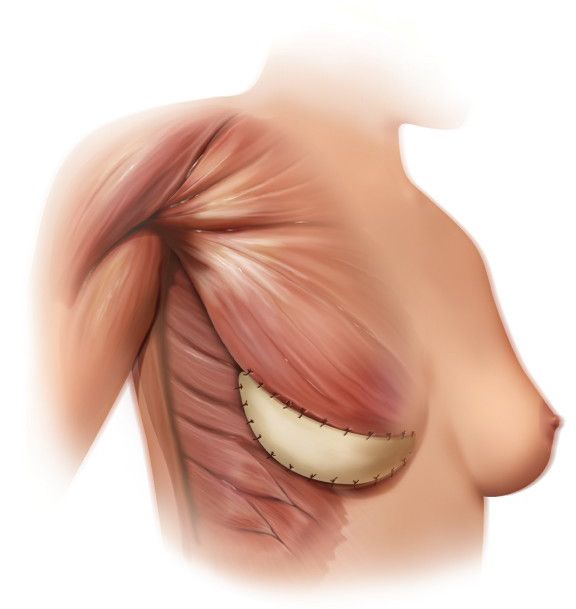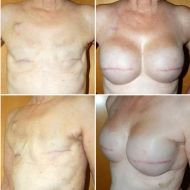Implant Reconstruction San Diego
The most common method of breast reconstruction currently performed in the United States uses staged tissue expansion and breast implants. This method of breast reconstruction is generally reserved for patients who are not candidates for, do not want, or do not have adequate tissue for a flap reconstruction. A breast implant (either saline or silicone) is used to reconstruct the missing breast tissue resulting from a mastectomy. For best results, the implant is placed beneath the pectoralis muscle in the chest wall. Since this muscle is quite adherent to the chest wall, there is usually not enough room behind the muscle to place a large enough implant to restore adequate breast shape and size.
Therefore, board certified plastic surgeon Dr. Gupta will use a technique called tissue expansion. Skin and muscle have elastic properties — they will stretch when placed on tension. We have all seen examples of this during pregnancy when an expectant mother’s abdominal skin and muscles stretch to accommodate the rapidly growing uterus. Stretch marks occur if the skin is stretched too rapidly. Dr. Gupta uses a similar technique to stretch the pectoralis muscle and breast skin to make enough room for a large enough breast implant. The breast tissue is stretched more slowly — over a period of three months — to avoid stretch marks.

Stage 1: The first stage involves placement of an empty tissue expander underneath the pectoralis muscle and the skin. This can be done at the time of the mastectomy (immediate reconstruction) or after the mastectomy has healed (delayed reconstruction). Expanders are temporary implants filled with salt water (saline). Dr. Gupta will usually fill some fluid into the expander at the time of the initial insertion procedure. To improve the results of the reconstruction and to create a more natural breast shape and texture, Dr. Gupta uses a tissue graft to cover the bottom part of the implant below the pectoralis muscle. This creates an internal breast sling to support the implant and reconstructs the natural tear-drop shape of the breast. This stage takes 45 minutes to an hour and can be done as an outpatient procedure.

Stage 2: Once the incision has healed, Dr. Gupta will start to gradually fill the tissue expander with sterile saline. This is performed by placing a small needle through the skin into an injection port built into the front of the expander. Dr. Gupta will fill the implant with small amounts of saline every one to two weeks to gradually expand the breast tissue. This expansion process will usually take between two and three months, depending on the patient’s skin characteristics and her desired reconstructed breast size.

Stage 3: Once the tissue expander has been adequately filled to achieve the correct reconstruction size, the second stage of reconstruction is planned. In this outpatient procedure, Dr. Gupta will remove the tissue expander and replace it with a permanent implant to reconstruct adequate breast size, shape and projection. It is at this stage that the patient and Dr. Gupta will decide whether to use a saline or silicone implant. This second stage is also when Dr. Gupta will perform reconstruction of the non-cancer contralateral (opposite) breast to achieve symmetry. This may include a mastopexy (breast lift), breast reduction, breast augmentation or combined mastopexy and augmentation. This stage takes 45 minutes to two hours and is done as an outpatient procedure.
Approximately three to four months following the placement of the breast implants, Dr. Gupta will plan the nipple-areola reconstruction to complete the breast reconstruction process. Overall from start to finish the process usually takes approximately six or seven months.

Some patients are candidates for a single-step breast reconstruction procedure whereby a permanent implant is inserted immediately following the mastectomy. This eliminates the use of an expander and the whole expansion process. In the one-step reconstruction the breast implant is completely covered by the pectoralis muscle and an acellular tissue graft (such as AlloDerm). Dr. Gupta usually reserves this single-stage procedure for patients undergoing prophylactic mastectomy or those who desire an A or B cup reconstruction.
Schedule a Consultation
Dr. Abhay Gupta has helped many women who have undergone mastectomy by providing them with beautiful breast reconstruction results. In addition to performing implant reconstruction, he offers DIEP Flap and Latissimus Flap surgery. To learn more, or to schedule a private consultation, call (858) 408-6100











